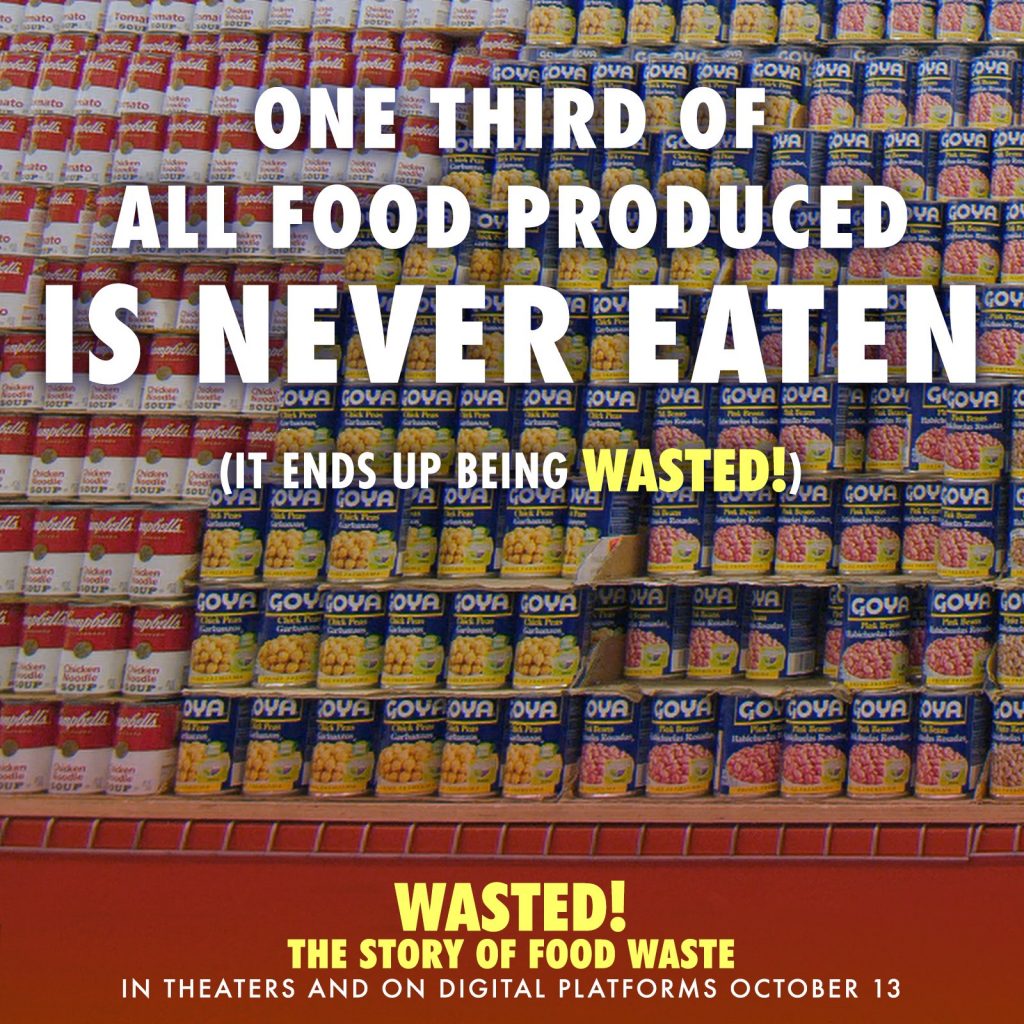Anyone who eats should watch this film
Anthony Bourdain’s documentary, Wasted! The Story of Food Waste, became available online and in select theaters last weekend. I watched it and I loved it. It features Bourdain, along with renowned chefs Dan Barber, Mario Battali, Massimo Bottura and Danny Bowien. View the trailer below.
The documentary starts off with the horrifying statistics on food waste:
- 1/3 of all food produced is never eaten
- Over 90% of wasted food in the US ends up in landfills
- The annual cost of food waste is 1 trillion dollars
- Food production is the single biggest cause of deforestation, the single biggest cause of water extraction, the single biggest cause of habitat loss and biodiversity loss
- 800 million people are starving
- 1.3 billions tons of food is wasted every year
We do not need to produce more. We need to act different. ~ Chef Massimo Bottura
The film breaks down food into a hierarchy of consumption and offers various solutions at each level—solutions that will inspire you, rather than depress.
1. Feed people first
Before talking about other solutions to deal with excess food after the fact, food waste prevention must come first. Every link in the food system needs to take part, from farms that have to leave their “ugly” produce in the fields, to the supermarkets that won’t take that produce, to restaurants that serve too much food, to consumers forsaking their common sense—and noses—to determine if their food has gone off.
In the film, chef Dan Barber, author of The Third Plate, says, “My first job as a chef is to cook tasty food.” He does so while using up everything. He goes on to say that we use all parts of the animal out of respect for that animal but we rarely do the same for a farm or a landscape. We grow cauliflower, for example—about 60 percent leaves—take the parts we want and toss the rest. He and his chefs use rejects—stems, leaves, immature zucchini—to create exciting dishes. (My mouth watered constantly watching this documentary.)
2. If excess food cannot feed people, feed it to animals
Chef Danny Bowien travels to Japan where the country has passed a food recycling law that diverts food waste from landfill to farms for animal feed. The pig farm featured in the documentary feeds its pigs Eco-feed, a brand of animal feed made from food waste, and in doing so, saves 50 percent on the cost of traditional feed. According to food-waste expert Tristram Stuart, feed accounts for 30 percent of the cost of running a farm. Eco-feed is probiotic, so these pigs consume good bacteria—not antibiotics—to stay healthy.
3. Convert food unfit for animals to energy
While we should avoid creating food waste in the first place, in reality, we do create it. So let’s use it wisely. The film features a yogurt factory that converts whey from Greek yogurt production into energy. “You can do that?!” you may ask. Cut off of oxygen in an anaerobic digester, anaerobic bacteria break down food and produce methane gas as a byproduct. The closed digester captures this methane gas and coverts it to energy. In the yogurt plant, this energy powers the filling and packaging machinery and saves the company $2.4 million a year.
4. Lastly, food waste can be composted
The documentary features a New Orleans elementary school that composts and grows food in the schoolyard garden. The teacher in charge of the garden said that before they started growing food, the kids ate chips, candy, soda… “They snacked horribly.” But, he said, when you give a child a seed and they plant it and tend that plant, they take responsibility for it—and then they eat it. The kids collect compost in buckets at lunch and the older ones eagerly add it to the compost heap outside, returning nutrients to the soil. Healthy soil makes healthy food—and healthy kids.
5. Food waste should NEVER go to landfill
Remember the methane digester in level 3? In a landfill, food breaks down the same way—but the methane escapes. Compacted in a landfill, food lacks exposure and so breaks down anaerobically, producing methane gas. Landfills emit this methane gas into the atmosphere. In the film, Tristram Stuart says methane gas is 23 times more potent that CO2. I have read much higher numbers.
South Korea set up a revolutionary system that weighs people’s food waste and sends them a bill at the end of the month for its disposal. Set up recently in 2013, the system has already nearly eliminated all landfill-bound food waste.
What we can do
At the end of the documentary, we hear more solutions, this time at the consumer level.
- Shop smart. Meal plan. Shop with a list. Buy local, seasonal food. Here’s a post I wrote on simple meal planning. It includes a one-page PDF planner.
- Cook more. Choose ugly produce. Cook with scraps. Use your freezer. Check out my recipe index for ideas. I update this index regularly.
- Compost what you can’t eat. Here’s a post I wrote on lazy composting. You need only a patch of dirt.
I don’t want to give the whole film away, and truly, I have only scratched the surface here. I took WAY more notes than I’ve shared here. In less than 90 minutes, these documentary filmmakers have crammed in a pile of information, uplifting stories and solutions to the food waste problem.
I watched Wasted! streaming on Amazon.
Be sure you make yourself a snack before watching. Enjoy!
My book won silver for single-subject cookbooks at the Taste Canada awards!
I’ve also won a second-place Gourmand cookbook award in the category of food waste. And my book was shortlisted for an award from the International Association of Culinary Professionals.

